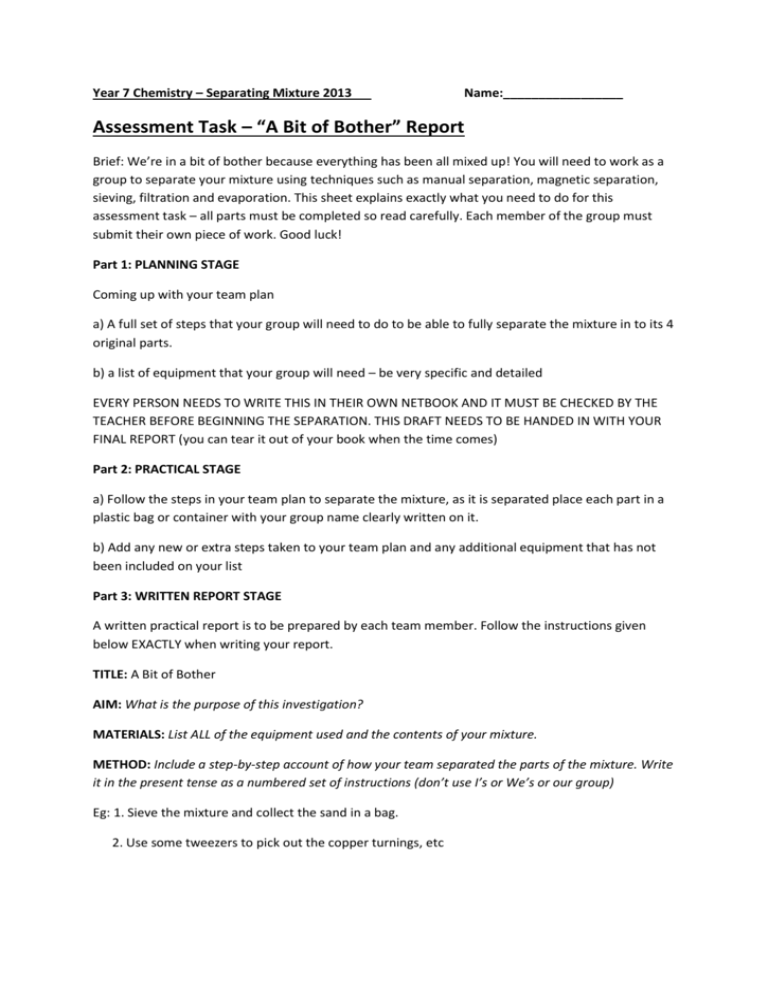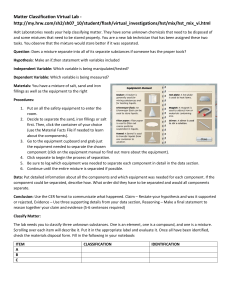A Bit of Bother Report
advertisement

Year 7 Chemistry – Separating Mixture 2013 Name:_________________ Assessment Task – “A Bit of Bother” Report Brief: We’re in a bit of bother because everything has been all mixed up! You will need to work as a group to separate your mixture using techniques such as manual separation, magnetic separation, sieving, filtration and evaporation. This sheet explains exactly what you need to do for this assessment task – all parts must be completed so read carefully. Each member of the group must submit their own piece of work. Good luck! Part 1: PLANNING STAGE Coming up with your team plan a) A full set of steps that your group will need to do to be able to fully separate the mixture in to its 4 original parts. b) a list of equipment that your group will need – be very specific and detailed EVERY PERSON NEEDS TO WRITE THIS IN THEIR OWN NETBOOK AND IT MUST BE CHECKED BY THE TEACHER BEFORE BEGINNING THE SEPARATION. THIS DRAFT NEEDS TO BE HANDED IN WITH YOUR FINAL REPORT (you can tear it out of your book when the time comes) Part 2: PRACTICAL STAGE a) Follow the steps in your team plan to separate the mixture, as it is separated place each part in a plastic bag or container with your group name clearly written on it. b) Add any new or extra steps taken to your team plan and any additional equipment that has not been included on your list Part 3: WRITTEN REPORT STAGE A written practical report is to be prepared by each team member. Follow the instructions given below EXACTLY when writing your report. TITLE: A Bit of Bother AIM: What is the purpose of this investigation? MATERIALS: List ALL of the equipment used and the contents of your mixture. METHOD: Include a step-by-step account of how your team separated the parts of the mixture. Write it in the present tense as a numbered set of instructions (don’t use I’s or We’s or our group) Eg: 1. Sieve the mixture and collect the sand in a bag. 2. Use some tweezers to pick out the copper turnings, etc RESULTS: Copy and complete the following table: Part of the mixture Separation technique used (filtration, evaporation, magnetic etc) Description of appearance and how pure it is (example: blue crystals 50% pure) DISCUSSION: Answer the following questions in full sentences. 1a) What techniques were used to separate the parts of the mixture? 1b) Why did each technique work to separate the parts of the mixture (eg, why did the magnet work to separate the iron filings?) 2a) How pure were the separated parts? Refer to the results table. 2b) Was your separation of the mixture successful? Why or why not? 2c) How would you improve the design of your investigation to increase the purity of the separated parts (what would you do better next time)? 3 Many techniques are commonly used to separate and concentrate mixtures to prepare everyday substances. Write down the best method for separating each of the following mixtures, giving a reason for your choice. a) salt from beach sand b) pure water from sea water c) mud from tap water d) stopping crickets from getting in your house e) steel cans from aluminium cans f) green smarties from the smartie packet CONCLUSION: Re-read the AIM and state whether it has been achieved or not -give reasons.








